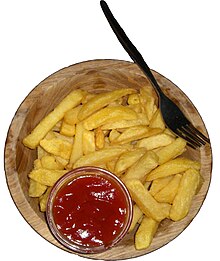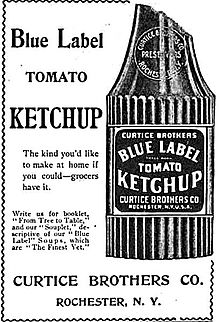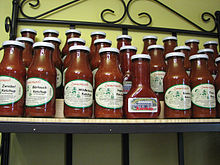Ketchup
Ketchup is a seasoning sauce that consists of sugar , tomato paste , vinegar , table salt and spices and is offered in different variations and flavors . The ketchup is often used in fast food , but is also widespread in everyday kitchens. Ketchup is traditionally used to supplement ready-made meals.
These include above all pan-fried or grilled food , schnitzel , sausages , potato dishes such as French fries or pasta dishes . Ketchup is also popular as a condiment for hamburgers and hot dogs .
Etymology and history

The earlier ketchup variations were much thinner and more bitter than today. The term ketchup initially originated in British cookbooks and then became commonplace in the USA until it finally came to German-speaking countries .
Andrew F. Smith has comprehensively presented all known attempts at derivation in his book Pure Ketchup . British cookbook author Elizabeth David believes that ketchup was derived from the English term caveach , a vinegar marinade for cooked fish. The US anthropologist E. N. Anderson favors the origin of the French word escaveche , which generally referred to food in a sauce , which in English then became caveach .
The most common perception is that the term comes from East Asia or Southeast Asia . Already in the 19th century there was the assumption that ketchup came from Malaysian . However, in Malay dictionaries the word is attributed to the Chinese language . In the Oxford English Dictionary there is the theory that it is an Anglicization of kê-tsiap , a word from the Amoy dialect in China , which is used to describe the liquid of fermented fish - a seasoned fish dip. Sinologists have pointed out, however, that this is also a word import, possibly from Vietnam .
Probably the origin is from Indonesian , there kecap simply means sauce, but is mostly used for a fermented sauce made from black soybeans . This meaning would be consistent with the early recipes for ketchup in English cookbooks. Originally, ketchup had nothing to do with tomatoes. This explains the often used descriptive name tomato ketchup .
The word ketchup - in the spelling of catchup - appeared for the first time in an English-speaking dictionary at the end of the 17th century and was defined as "high East-India Sauce" (fine East Indian sauce). "East India" was a general term for South and Southeast Asia at the time , not specifically for Indonesia. The second mention came in 1711 in a book called Account of the Trade in India by Charles Locker. The first recipe for “English ketchup” was published in a guide for housewives in 1727. The ingredients given were anchovies , shallots , white wine vinegar , white wine and various spices. The recipe was similar to that for a fish sauce .
In 1732 Richard Bradley published a ketchup recipe in a magazine with the note that it came from "Bencoulin in the East Indies". Bencoulin was a trading post of the British East India Company in Sumatra . The main ingredient for this ketchup was kidney beans as a substitute for soybeans that are not found in Europe; the consistency of the sauce was more like a paste. It was diluted with liquid if necessary.
The new seasoning sauce called ketchup quickly became popular in England and various recipes were published in all cookbooks. In the middle of the 18th century, ketchup was already available as a ready-made sauce in shops. The preparation was mostly based either on mushrooms, fish or walnuts . However, there were also variants with mussels and oysters . Ketchup also became known in the USA through British cookbooks. In 1812, the first recipe for such a seasoning sauce based on pureed tomatoes appeared here. It may have been inspired by recipes for Italian tomato sauce , the first of which appeared in Britain in 1804. The difference was that vinegar was added to the ketchup and the result was a long-life fermented sauce.

Tomato ketchup was already common in the United States by the mid-19th century, but other varieties continued to exist. Most of the ketchup was made in the households themselves. That only changed in the mid-19th century, when ketchup was a by-product of the manufacture of canned tomatoes and was increasingly produced industrially. The preparation was based on the well-known recipes in cookbooks. Today's market leader Heinz was initially just one of many manufacturers in the USA. His early recipes have been handed down. One from 1883 contained tomatoes and vinegar, cloves , cayenne pepper , nutmeg , cinnamon and allspice . A second recipe called ginger , mustard seeds , celery , horseradish and brown sugar as ingredients. From around 1900 the company was market leader in the USA, and in 1905 it produced five million bottles of ketchup. According to press reports from February 2019, the company's market share in Germany for branded ketchup is 46.7%.
The earlier ketchup variations were much thinner and more bitter than today. In the 1920s, controversy arose in the United States over the preservative sodium benzoate . The recipes were then changed and used instead of fully ripe green tomatoes. The varieties then produced by today's market leaders were therefore characterized by a considerably higher content of pectin and, due to the (natural) glutamates (cf. Umami ), a considerably smoother consistency and a heartier taste. This has contributed significantly to the widespread use of ketchup in the United States and beyond today. In Eastern Europe , paprika and tomato pastes and purees (including Ljutenica , Ajvar ) are still widely used , similar to ketchup, to preserve the perishable vegetables.
In Germany, ketchup was initially only available as an imported product in specialty shops since the beginning of the 20th century. However, there was already a recipe for "tomato catsup" in a cookbook published by J. Weck in 1912. In 1937, the then manufacturing company and today's food manufacturer Zeisner in Bremen produced "Germany's first ketchup". Ketchup became more widely known in Germany after 1945 through the British and American occupation soldiers and has also been widely used since the 1950s. A well-known application together with a typical German specialty is the currywurst .
sorts
In Europe and the USA, there are basically three types of ketchup:
tomato ketchup
It is true that the tomato is the basis for all types of ketchup commercially available today ; in tomato ketchup, however, this is the essential ingredient. Tomato ketchup is by far the most widespread type of ketchup in Germany with 70 percent of the total supply.
According to the guidelines of the Federal Association of the German Delicatessen Industry, tomato ketchup consists of tomato paste, sugar - mostly in the form of sucrose or a mixture of sucrose and other types of sugar - vinegar, salt, onions , garlic and spices as well as additives and flavorings. The addition of thickeners, starches and preservatives is permitted by law. According to the guideline, the tomato dry matter content must be at least seven percent, which corresponds to a tomato paste content of at least 25 percent.
However, this guideline only applies to tomato ketchup, recipes for special ketchup products such as curry ketchup are left to the manufacturers themselves. According to the German Food Ordinance, ketchup may contain flavorings, thickeners and flavor enhancers , but no artificial colors.
In addition to vitamin C , ketchup also contains the carotenoid lycopene , which is increasingly released when fresh, fully ripe tomatoes are heated during processing. This is said to have health-promoting and cancer risk-reducing properties.
Spice Ketchup
The spice ketchup variety includes all types of ketchups whose ingredients go beyond normal tomato ketchup , such as the addition of cucumber , bell pepper or chili peppers. Also found in spice ketchup often a greater amount of additives.
These include, for example, barbecue ketchup (usually called “barbecue sauce”), “hot chili sauce”, “ steak sauce” or so-called “gypsy ketchup”, usually referred to as gypsy sauce in the trade . It contains shallots , mustard , anchovy paste , paprika and, as the main characteristic, garlic . This variant originally comes from Hungary or Italy, which was originally a thin paprika sauce with pieces of fruit ( Letscho or Peperonata ). This is similar to the earlier ketchup varieties in terms of consistency and taste. It only became a modern variant of ketchup because of the added tomato paste, the thixotropic consistency and the finer grain of the fruit pieces.
Curry ketchup
Around 20 percent of the ketchup sold in Germany is curry ketchup . The basic recipe is supplemented with coordinated curry mixes. Curry ketchups are also often spicy, for example by adding cayenne pepper .
Manufacturing
For industrial production, the tomato paste is fed into a kettle with spices, sugar and vinegar, mixed and heated. During this homogenization , all ingredients are finely distributed and chopped up to the desired consistency. Further processing can be carried out either cold under vacuum or hot in the colloid mill . Chunky ingredients are mixed with the ketchup in a buffer vessel with a stirrer downstream of the colloid mill and later filled cold or hot under vacuum. The cold products are often preserved with sorbic and benzoic acid . After heating, the product passes through a vacuum ventilation system and is filled into hot glasses or, after cooling to around 70 ° C, into buckets.
It is believed that nanoparticles are added to some types of industrial ketchup without being specifically labeled. Here, silicon dioxide is used to make ketchup thicker.
The preparation of ketchup in the household is possible within a short time with long-term storable food. In the simplest case, equal parts of tomato paste and honey are mixed together to form a paste, which is seasoned with vinegar and salt and brought to the desired consistency by adding water.
Others
Viscous ketchup becomes thinner again after extensive shaking of the container - this phenomenon, which is not limited to ketchup, is scientifically known as thixotropy .
In 1981, David Stockman , the budget expert under US President Ronald Reagan , suggested declaring ketchup as a vegetable . This was intended as part of Reagan's plans to cut budgets on state-funded school meals . This would have made it cheaper to meet the requirements for the proportion of vegetables in school meals. This proposal was rejected and the corresponding legislative initiative stopped.
When the then acting chairman of the Council for German Spelling , Hans Zehetmair , was asked in 2004 whether the word ketchup could also be spelled ketchup in the future , he replied that since he did not like the product, he had never thought about the word ketchup excited. It is "a hideous word for a hideous thing".
Web links
Individual evidence
- ↑ Ketchup on Duden.de ; accessed on September 29, 2019
- ↑ Andrew F. Smith: Pure Ketchup: A History of America's National Condiment , 1996, ISBN 1570031398 , pp. 4 ff.
- ↑ a b c Andrew F. Smith: Pure Ketchup: A History of America's National Condiment , 1996, ISBN 1570031398 , pp. 12 f.
- ↑ Andrew F. Smith: Pure Ketchup: A History of America's National Condiment , 1996, ISBN 1570031398 , pp. 14 ff.
- ^ Andrew F. Smith: Pure Ketchup: A History of America's National Condiment , 1996, ISBN 1570031398 , p. 43
- ↑ Kraft-Heinz: How Edeka is forced to develop a new ketchup , report of the daily newspaper Tagesspiegel from February 22, 2019, accessed on February 24, 2019
- ↑ Empty shelves again? Kraft Heinz and Edeka are apparently arguing about prices , report by the business magazine Wirtschaftswoche from February 22, 2019, accessed on February 24, 2019
- ↑ J. Weck GMBH (Ed.): Cook in advance! Handbook for the freshness of all foodstuffs with the Weck facilities, 9th edition, Öflingen 1911, p. 84.
- ↑ Sebastian Manz: Belgians love ketchup from Bremen. The Zeisner company produced Germany's first ketchup / Today the company is internationally active. In: Kurier am Sonntag , Markets & Macher section , Bremen, July 31, 2011, p. 20.
- ↑ Information service Agriculture - Food - Rural Areas , accessed on November 24, 2009.
- ↑ Mini-particles in the food red milk and pizza multi. From: sueddeutsche.de , November 1, 2006, accessed on June 11, 2012
- ↑ Nanotechnology Environmentalists warn of nano-invasion in food. At: spiegel.de , March 11, 2008, accessed on June 11, 2012
- ↑ Axel Hacke : And what do I do now? In: Der Tagesspiegel , December 5, 2004, accessed on November 24, 2009.


